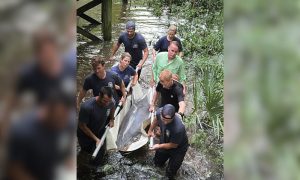Fracking is causing more toxic, chemical-laden water to spill into our earth than previously estimated by the EPA, a new study found.
The study, which was conducted from 2004-2015 by researchers from Duke University, looked at the frequency and size of oil and gas spills in four states—Colorado, New Mexico, North Dakota and Pennsylvania—and found that fracking caused 6,647 spills in 10 years. The researchers created an interactive map to plot the spills. North Dakota had the most spills (4,453 incidents), followed by Pennsylvania (1,293 incidents), Colorado (475 incidents), and New Mexico (426 incidents).
“Given the rapid recent development of unconventional oil and gas development, data are scarce on both how often spills happen, where in the process they occur, and what caused them,” said Lauren Patterson, lead author of the study and policy associate at Nicholas Institute for Environmental Policy Solutions, in an interview with Lady Freethinker. Many of these spills were caused by equipment failure or human error, particularly while loading and unloading materials. And most spill incidents occurred within three years of the wells being built, according to Patterson.
Because state requirements differ on reporting data regarding the frequency of spills, the EPA estimates vary; in a May 2015 report, the agency reported only 457 fracking-related spills in 11 states between 2006-2012. “This study points to the need for more uniform, consistent data collection across states to ensure that states and industry can better address spill causes and reduce the risk of future spills,” said Patterson.
The impact of these spills on the environment and health was not included in the study.
“The presence of a spill does not mean an adverse impact,” Patterson said. “Many spills were small or contained, and some were of freshwater.”
The materials used in fracking vary by company and are unregulated. In the U.S., 750 compounds have been listed as additives to fracking fluid. These include hydrocarbons, toxic and radioactive material.
A previous study found that toxic chemicals such as radium, selenium, thallium and lead can persist for years at unsafe levels following a spill.






